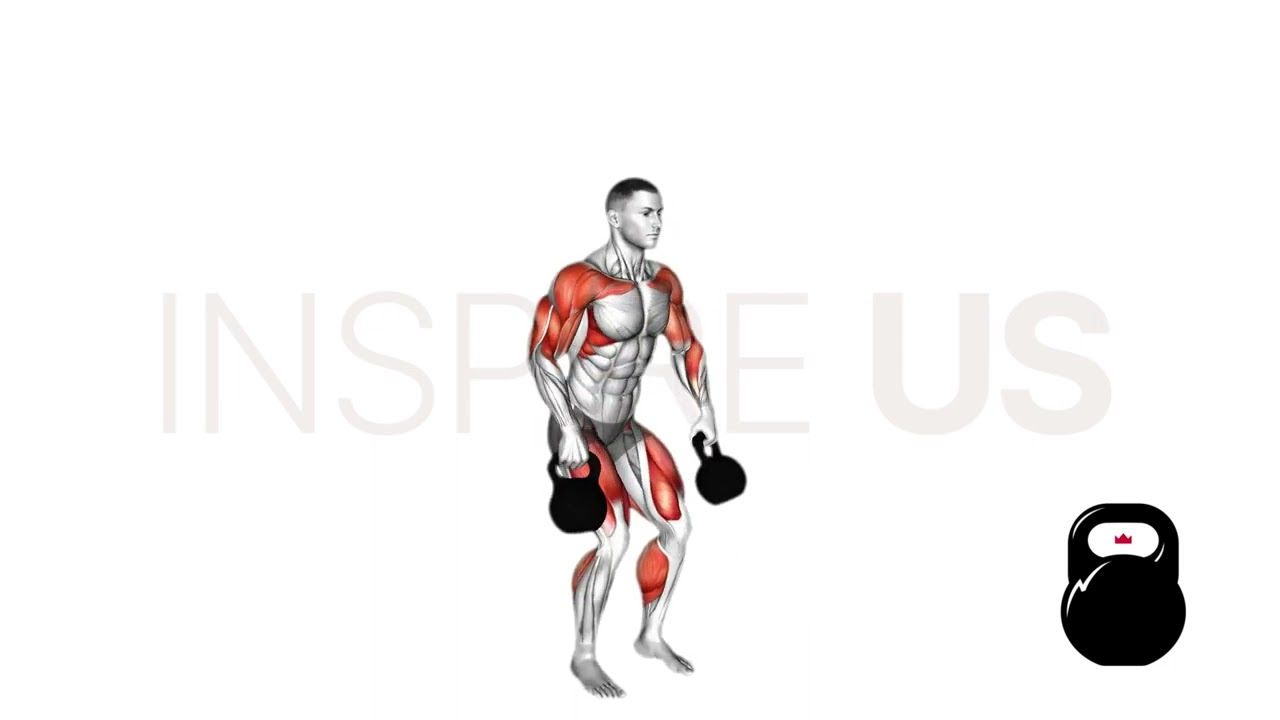Kettlebell Clean And Jerk: Benefits, Muscles Worked, and More
In Crossfit and other forms of functional resistance training, the usage of kettlebells is often preferred for its capacity to create more convenient and explosive movements.
When this concept is applied to the already explosive clean and jerk, we get a movement that is almost custom-tailored for athletes or individuals who wish to train their athletic capabilities in the most effective way possible, hence the development of the underrated kettlebell clean and jerk exercise.
The kettlebell clean and jerk is a highly effective variation of the standard Olympic clean and jerk, with several differences in form that make greater use of the entirety of the body’s musculature - especially those of the posterior chain and shoulders.
What is the Kettlebell Clean and Jerk?
In technical terms, the kettlebell clean and jerk is a closed chain compound resistance movement primarily seen in Crossfit “WODS”, athletic training programs and as a supplementary compound movement in competitive Olympic weightlifting programs.
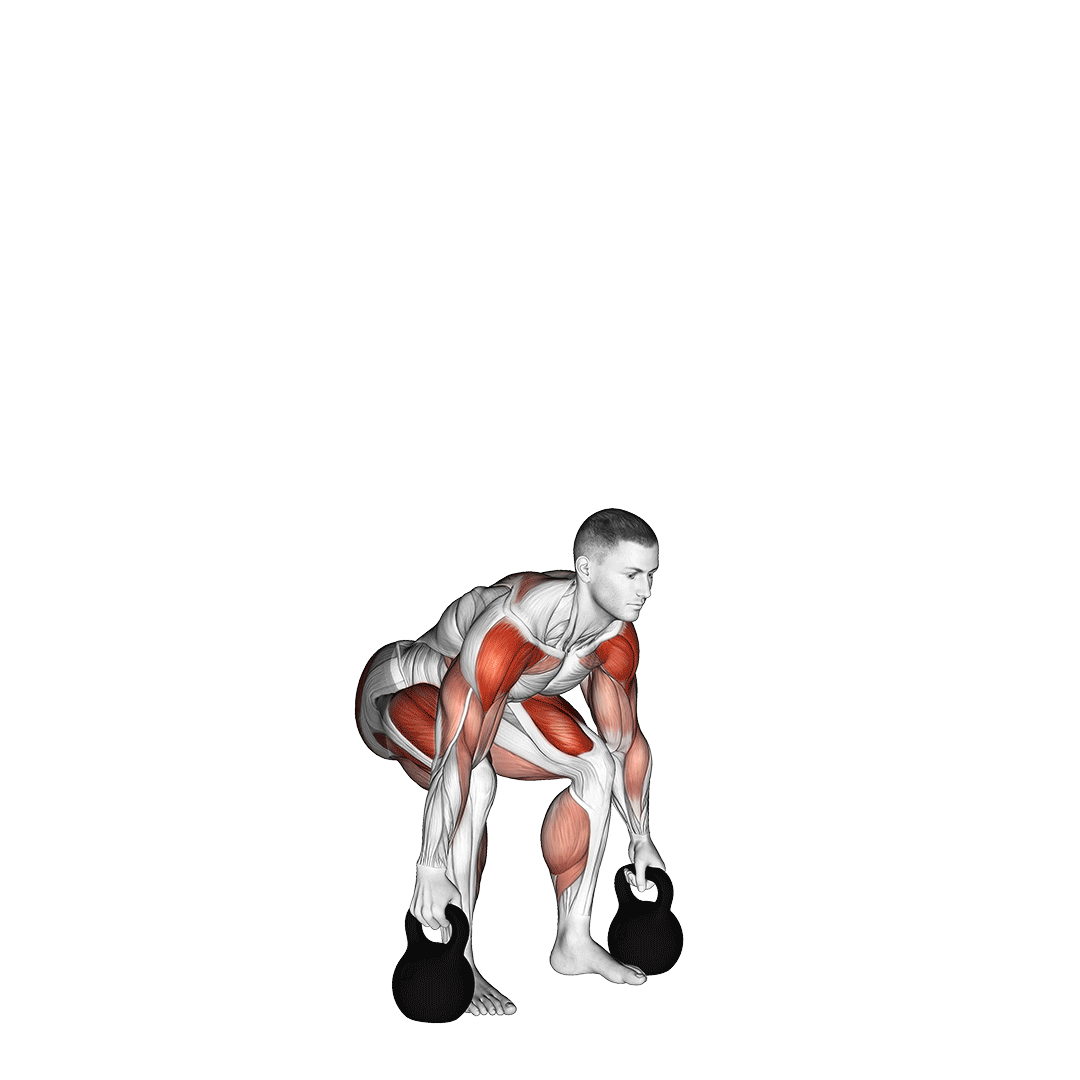
It has seen increased use in recent years due to its capacity to aid in control over the barbell during the conventional clean and jerk, as well as its convenience as it is capable of being performed with only a single moderately-weighted kettlebell.
Despite common belief, all variations of the clean and jerk are not in fact meant to involve any sort of isometric muscular contraction or “grinding” whatsoever, with the majority of the force in fact taking place during the initial clean in an explosive manner.
How is the Kettlebell Clean and Jerk Performed?
Initial Stance
To set-up for a repetition of the kettlebell clean and jerk, the exerciser will enter a squatting stance with the kettlebell placed on the ground, parallel with the ankle.
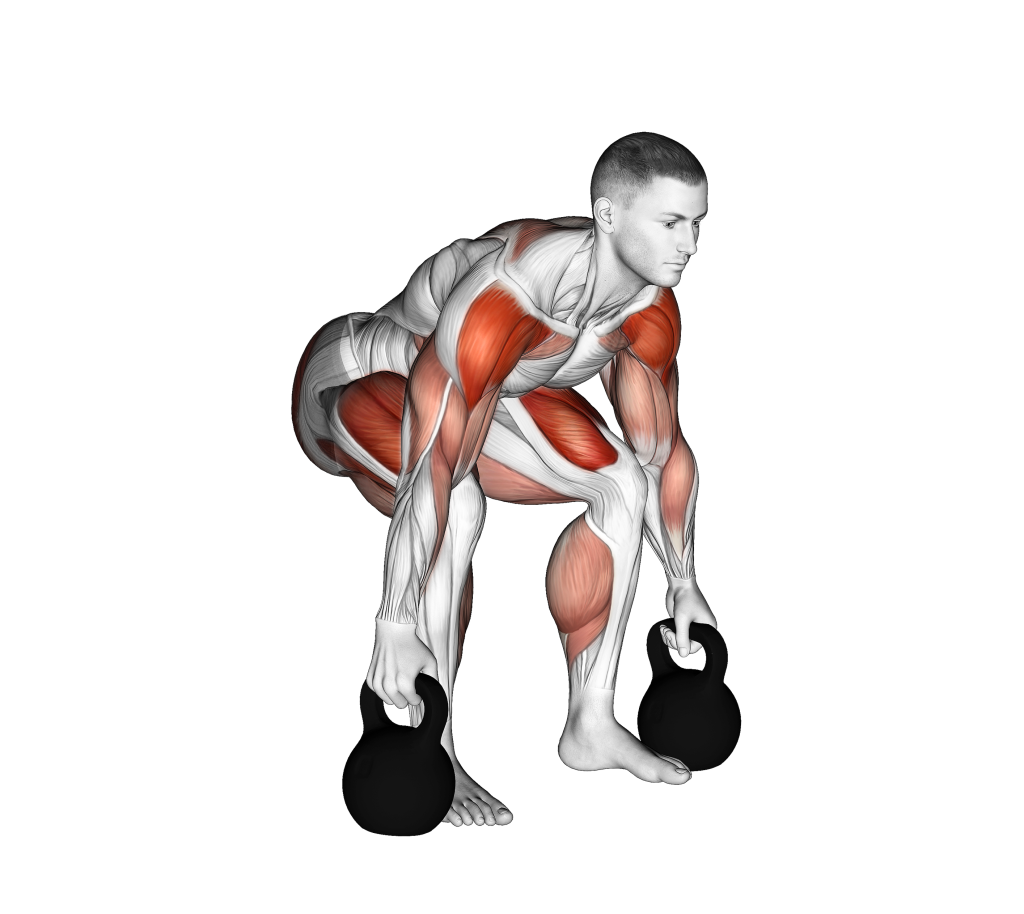
Ensuring that the lower back is neutral and that the core is contracted, the exerciser will place one pronated hand on the curved part of the kettlebell handle, not the middle. This will ensure that the forearms are not damaged by the weight swinging against them during the jerk phase of the movement.
Kettlebell now gripped between the legs, the exerciser will straighten somewhat as they prepare for the repetition.
The Clean Phase
To begin the initial phase of the repetition, the exerciser will pull the kettlebell upwards and thrust forward with the hips simultaneously, thereby drawing the kettlebell in a vertical arc as the arm naturally rotates.
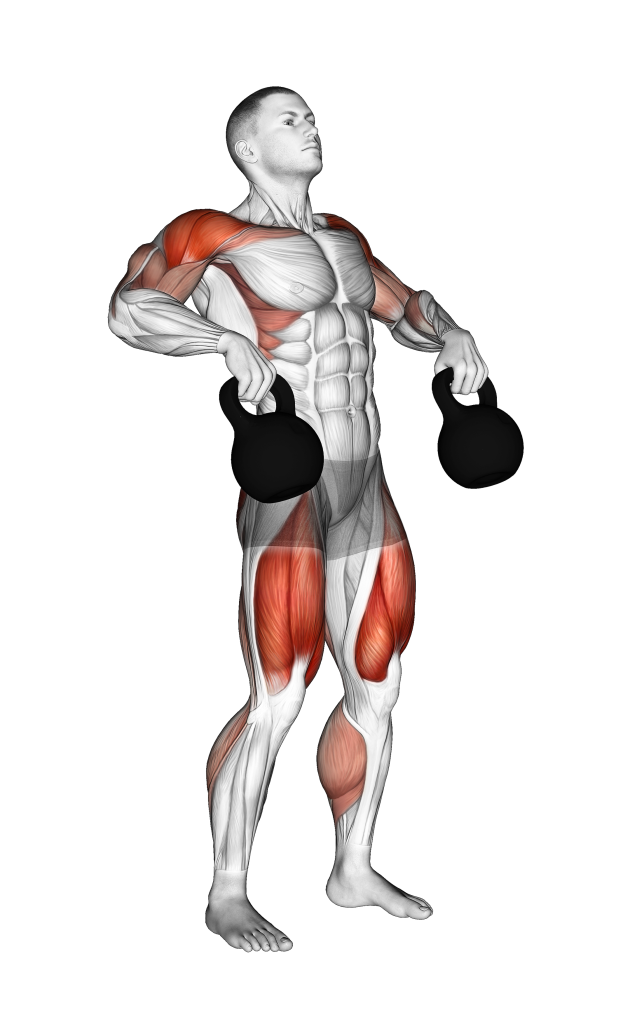
The weight will come to a stop at the “chest shelf” or rack position, with the elbow bent and the wrist pulled somewhat backwards as the kettlebell stops somewhere along the top or front of the shoulder.
For the ideal level of control over momentum, the exerciser may wish to shorten the arc and keep the weight closer to the body as they clean it upwards.
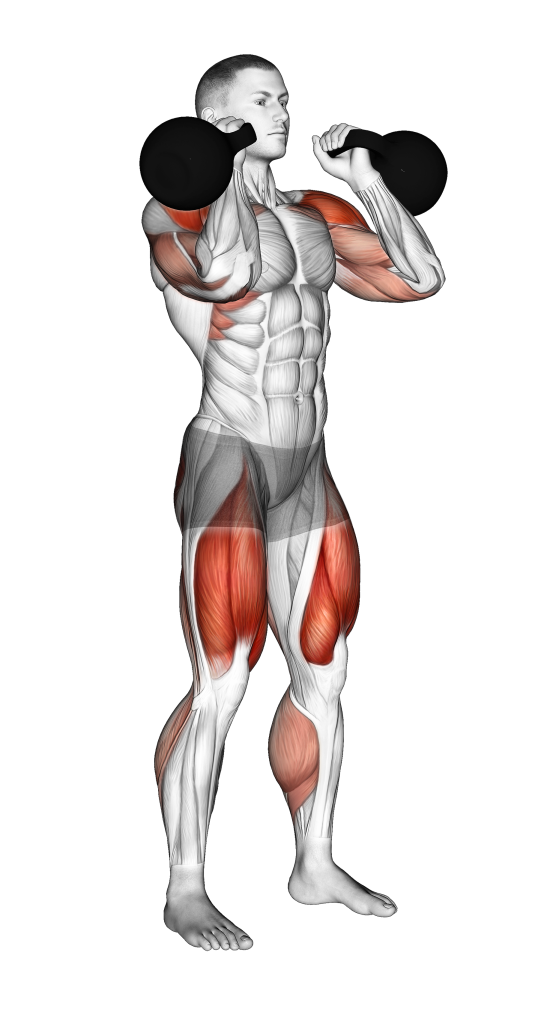
As the kettlebell comes to a rest, the wrist and forearm must remain relatively vertical in position, with as little tilt in relation to the elbow as possible.
This will synergize with the grip of the exerciser on the side of the handle, allowing for a reduced risk of injury while also maximizing control over the weight.
The Jerk Phase
Now that the clean phase is complete and the kettlebell is resting in the front racked position, the exerciser is in the initial stance of the overhead jerk movement.
Contracting the core and keeping the head facing forward, the exerciser will dip somewhat at the knees, generating force and momentum that will be translated through the arms.
The moment quarter squat depth is reached, the exerciser will push through their heels and extend the knees simultaneously, moving the kettlebell upwards by extending the arm upwards in concert with the extension of the knees.
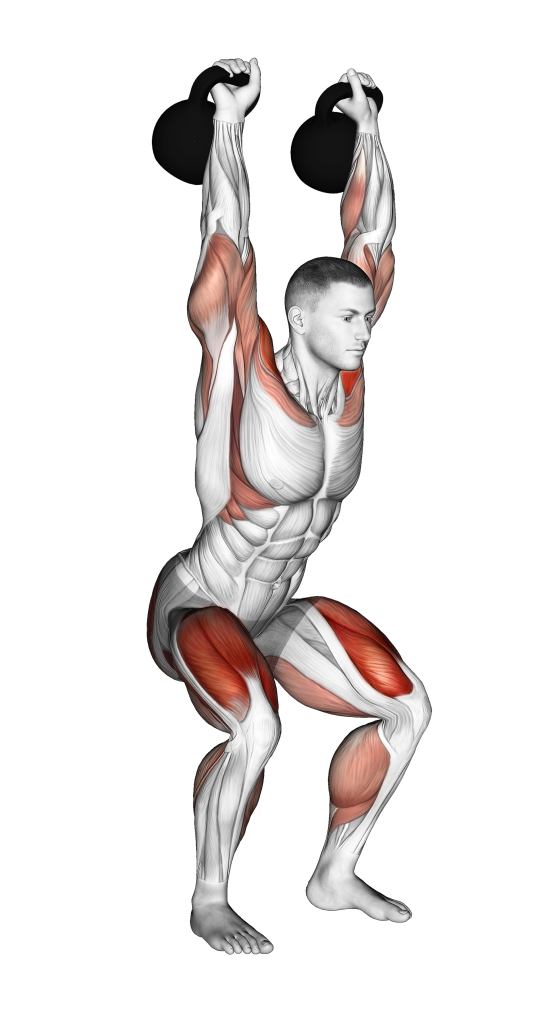
As the weight moves into the terminal position overhead, the exerciser will dip the knees once more - this time moving beneath the kettlebell.
Once the arms are fully supporting the kettlebell overhead in a fully extended position, the repetition is now complete.
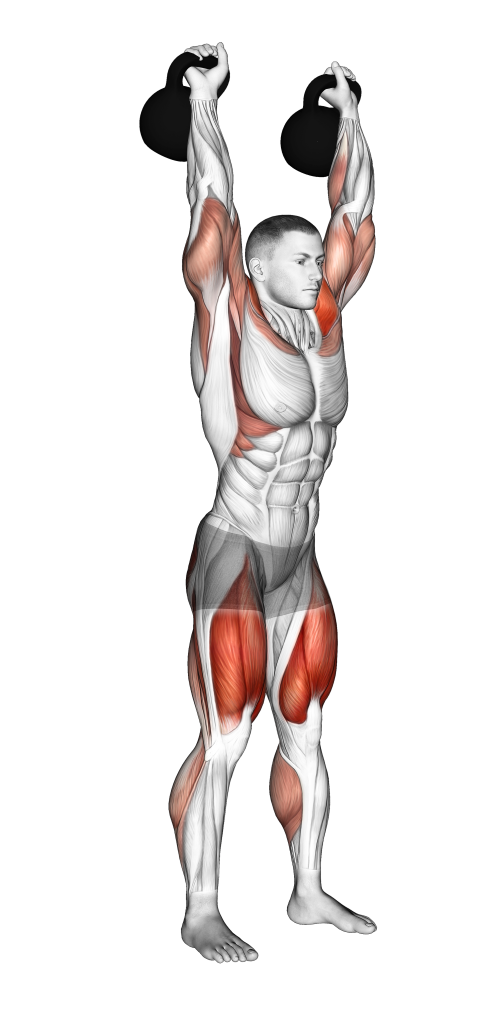
Combining these phases together:
Muscles Worked by the Kettlebell Clean and Jerk
Because of the fact that the kettlebell clean and jerk is a compound movement that activates nearly every muscle group in the body, it is less of a question of what muscles are trained by the exercise, and more of to what extent any particular muscle is recruited throughout the movement.
Primary Mover Muscles
The muscles recruited to the greatest extent by a repetition of the kettlebell clean and jerk are; the various muscles of the hamstrings and glutes, the quadriceps femoris, the triceps brachii, the majority of the upper back (including the lats) as well as the deltoids in some capacity.
These muscles are responsible for producing the greatest amount of force throughout the movement, and will otherwise remain contracted to some level regardless of what phase of the kettlebell clean and jerk is being performed.
Secondary Mover Muscles
Other muscle groups that are recruited to a lesser degree or otherwise recruited sparingly throughout the movement pattern of the kettlebell clean and jerk are; the core musculature (excluding the serratus), the pectoralis minor muscle, the erector spinae, the calves and the anterior hip flexor muscles.
Benefits of the Kettlebell Clean and Jerk
Apart from the usual effects of resistance training, the kettlebell clean and jerk will also come with several unique benefits that it only shares with other multi-joint compound movements of its type.
These benefits make the kettlebell clean and jerk uniquely useful for athletes and certain types of competitive weightlifters that require improvements in their explosiveness.
Greatly Improved Athletic Ability and Explosiveness
The kettlebell clean and jerk combines full-body conditioning with a need for proper technique work and utilization of lower body explosiveness in a manner that makes it quite applicable to athletic training programs.
Even when performed at low volume, the numerous muscle groups recruited in a simultaneous and rapid manner by a repetition of the kettlebell clean and jerk can result in excellent training stimulus of fast-twitch muscle fibers.
As such, the kettlebell clean and jerk is arguably more effective as an athletic training tool than its barbell based counterparts - so long as the athlete is not an olympic weightlifter, that is.
Strengthened Core Muscles
Strength and control through the core musculature is absolutely essential when performing a kettlebell clean and jerk repetition, as it will both translate force produced by the lower body as well as ensure that the torso and arms are kept in place despite the technical and rather explosive movement pattern of the exercise.
Knowing this, it can become quite plain to see that regular performance of the kettlebell clean and jerk will eventually lead to stronger and more responsive core musculature, especially in regards to the abdominal muscles which are contracted both dynamically and isometrically throughout the exercise.
Full-Body Conditioning - Including the CNS
One largely overlooked portion of athletic physiology is the central nervous system, of which can become fatigued if not properly conditioned and subjected to high volume compound exercises.
This is where the kettlebell clean and jerk shines, as it is excellent at conditioning both the musculature of the body as well as the central nervous system behind the contraction of said muscles - improving both conscious control and allowing the exerciser to delay full fatigue.
Excellent Carryover to Other Olympic Weightlifting Movements
As the conventional barbell clean and jerk is a competition lift in many olympic weightlifting events, it should be no surprise that practicing with a variation of said clean and jerk can result in significant improvements.
Not only does incorporating the kettlebell clean and jerk into your routine improve conventional clean and jerk performance, but so too does it aid in other exercises that fall under the classification of olympic lifts, such as the snatch or the prerequisite individual jerk or clean movements.
How to Program the Kettlebell Clean and Jerk
Due to the explosiveness and intensity of the kettlebell clean and jerk, performing high volume sets may be inadvisable unless it is placed among the first exercises within a training session.
Furthermore, contrary to what many believe, the weight of the kettlebell does not need to be high in order for the clean and jerk to be an effective exercise.
Approximately 60-75% of your conventional barbell clean and jerk weight should be more than enough, especially if performing the exercise unilaterally.
For olympic lift novices just getting into explosive resistance training, 2-3 sets of 6-8 repetitions each should be sufficient enough to provide technical practice and also condition the entirety of the body while avoiding overtraining.
Common Mistakes of the Kettlebell Clean and Jerk
Gripping the Center of the Handle
Though not as egregious a mistake as others, gripping the center of the handle will reduce the rotational ability of the kettlebell, causing it to strike against the shoulder and forearm for individuals of certain proportions.
This can lead to bruising and discomfort, which is the main complaint among performers of the kettlebell clean and jerk.
Furthermore, gripping the center of the handle can increase the distance between the actual weight itself and the hands, leading to greater instability and a minor loss of control over it.
“Rack” the Kettlebell Properly
While many lifters will prefer to immediately transition to the jerk phase of the exercise once the kettlebell has reached sufficient elevation, it is good form to ensure that the kettlebell is resting in the front rack position at approximately clavicle-level so as to generate greater force from the legs and ensure that the kettlebell is in a safe position to push upwards.
A properly racked kettlebell prior to performing the jerk should have the elbow relatively parallel to the floor, with the core braced and the wrist in-line with the forearm, lower body ready to initiate a push.
Over-Involved Pelvis, Unrecruited Posterior Chain
Whether it be during the initial movement of a clean or prior to transitioning to the jerk phase, pushing the hips too far forward and failing to utilize the posterior chain simultaneously can be disastrous.
Not only will doing so lead to a greater risk of losing your balance, but it will also reduce the amount of force generated by the lower body as the kettlebell is moved upwards.
While many lifters assume that the pelvis moving forward as a result of glute muscle contraction is entirely normal, this is in fact not the entire movement, and it is often advantageous to perform a slight dip with the buttocks prior to initiating a lower body push so as to allow for full posterior chain contraction.
Jerk Phase Force Coming from Shoulders
During the jerk phase of the kettlebell clean and jerk, the majority of the force used to push the kettlebell overhead should come from the lower body, with the deltoid or shoulder muscles acting only to control the direction in which the weight is moved.
This is simply because the deltoids will quickly become fatigued or otherwise overwhelmed by the weight of the kettlebell, and that the entire point of the clean and jerk is full-body force development, rather than deltoid muscle recruitment.
Failing to Cushion with Knees and Hips
As the kettlebell comes to a stop during the clean phase of the exercise, much of the impact of the kettlebell can be reduced by cushioning with the knees and hips, bending slightly as the weight comes to a stop next to the shoulders.
Not only will this aid in controlling the weight, but can also help provide a seamless transition to the clean phase of the exercise, making the movement far smoother and efficient.
Frequently Asked Questions (FAQ)
What’s the Difference Between Clean and Jerk & Clean and Press?
The main difference between a clean and jerk or clean and press movement is simply the second phase of the exercise.
The clean and jerk will involve far more explosiveness and leg drive as the lower body pushes the weight overhead, whereas the clean and press will not involve leg drive during the second half of the movement, instead using the shoulders to “press” the weight upwards.
Do Kettlebell Cleans Build Biceps?
While any sort of clean exercise will indeed recruit the biceps, they are not the focal point of the exercise and as such should not be recruited to a great intensity.
In particular, the biceps will see their greatest usage near the end of the movement, where the kettlebell is rotating alongside the hand into a rack position.
Can You Do Kettlebell Cleans Everyday?
Unless specifically following a training program with daily training frequency - no, it is best to stick to a frequency of 2-3 training sessions involving kettlebell cleans per week.
This is because of the intensity of the exercise, and the need for a certain length of time in which to recover between workout sessions.
In Conclusion
Remember that it is best to start with a very low amount of weight, as getting used to the motion of a kettlebell may take some time - even for individuals already familiar with barbell clean and jerks.
And as always, if you’re still unsure of how to perform or program the kettlebell clean and jerk, there is no shame in asking for help from a professional athletic coach.
References
1. Pierce, Kyle EdD, CSCS. Clean & Jerk. Strength and Conditioning Journal 21(3):p 46, June 1999.
2. Manocchia, Pat; Spierer, David K; Minichiello, Jackie; Braut, Steven; Castro, Jessica; Markowitz, Ross. Transference Of Kettlebell Training To Traditional Olympic Weight Lifting And Muscular Endurance. Journal of Strength and Conditioning Research 24():p 1, January 2010. | DOI: 10.1097/01.JSC.0000367164.33477.62

